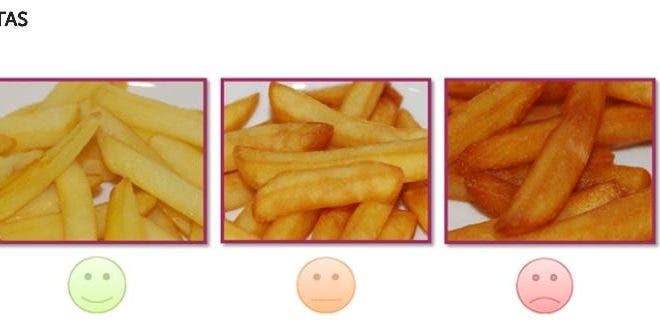Acrylamide is a toxic compound that appears in some foods when they are processed at high temperatures, such as French fries or bread. But there are also other pollutants such as furan or polycyclic aromatic hydrocarbons that also arise in heat treatment.
For this reason, a European Commission regulation aimed at the food industry has just entered into force last April, which establishes measures to reduce acrylamide levels in food.
And the objective is to increase consumer protection since in animals there is scientific evidence that acrylamide “can increase the risk of suffering from cancer”, with children being the most exposed age group given their lower weight, the regulation specifies.
“At the moment the consumer should not worry, they have to flee from scaremongering, but they should know the measures that they should also apply at home when cooking food to avoid the formation of acrylamide”, explains Eva Molina, inspector in the Service of Control of Food Safety in the Valencian Community.
Acrylamide, in foods rich in carbohydrates
Acrylamide is an organic compound that is formed when certain foods are made at temperatures above 120 degrees and with low humidity.
This toxin appears mainly in foods rich in carbohydrates, baked or fried, since its raw materials contain precursors such as sugars and amino acids (especially asparagine).
The European regulation refers to fresh potato chips and potato chips, bread, breakfast cereals, bakery products, pastries, pastries and cookies; coffee (roasted and instant) and its substitutes and baby food.
The companies that manufacture these products must undergo the mitigation measures established in the regulations and will be subject to sampling and analysis to see if they comply with the established acrylamide levels.
“It is about the industry reducing the level of acrylamide by applying measures that until now were done on a voluntary basis and now are mandatory,” explains the also pharmacist, specialized in public health, and a doctor in Food Sciences.
“The European Commission – he adds – applies the precautionary principle with this regulation, it is like a small voice of warning before a problem that we must control but in the meantime, we must continue investigating” to obtain scientific evidence on its impact on humans.
Also caution at home
This intense heat causes foods to toast and when they reach that dark brown color it is the indicator that acrylamide has formed.
This process is called the Maillard reaction and it is the same process where the compounds that promote the taste and smell of these foods are also formed.
Baking, frying, roasting and cooking are the main culinary techniques in which acrylamide is formed in the most prone foods.
The Spanish Agency for Consumption, Food Safety and Nutrition (AECOSAN) offers a general recommendation to reduce the presence of acrylamide: avoid toasting food and even burning it. “Golden, but not past” could be a motto.
For potatoes the tips are:
Store in a dark and cool place, avoid the refrigerator as it promotes the release of sugars and thus, greater acrylamide formation during cooking.
If you fry them, follow the time and temperature recommendations (maximum 175º) on the container.
If you fry small amounts, reduce the frying time.
Whether cooked fried or baked, golden color is preferable to dark brown.
On the other hand, the specialist Eva Molina recommends that before making the fried or baked potatoes it is convenient to wash them in hot water and let them rest for a few minutes. With this we get the sugars from the potato to go into the water and the potatoes with less sugar, less acrylamide precursor they present.
For the toasts:
If you make toast or pre-cooked bread, golden is preferable to dark.
The expert Eva Molina explains that, when there are precooked foods that must be finished at home (such as baked bread or frozen potatoes), the product labeling should be looked at because the new regulation establishes that the industrialist has the obligation to indicate which is the exact process that the consumer must apply at home to avoid acrylamide formation.
Regarding bag potatoes, the inspector advises to discard those with dark or burned areas.
Furan
Another contaminant that appears in food treatment is furan, an organic compound that is formed during heat treatment of food and contributes to the sensory properties of the product, according to AECOSAN.
“It is produced by the heat treatment of food and is broken down into sugars and fats. It is a volatile compound that evaporates in the thermal process; the problem is when the food is packaged directly, without the furan having evaporated ”, explains Eva Molina.
It is associated with coffee, soy sauce or baby foods, such as baby food, indicates the expert who recommends heating the latter product in a water bath with the container open so that this compound evaporates before consumption.
Furan has also been shown to be a carcinogen in animals but its effect in humans is unknown, although it may cause liver damage.

